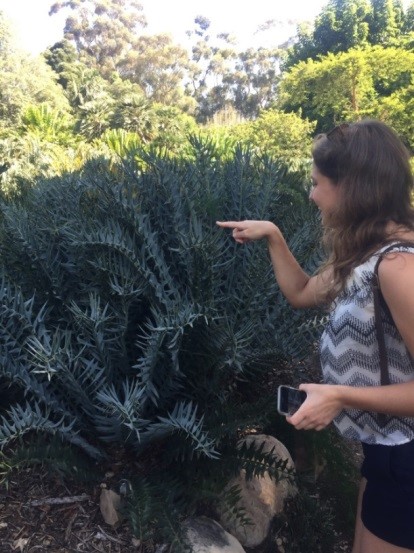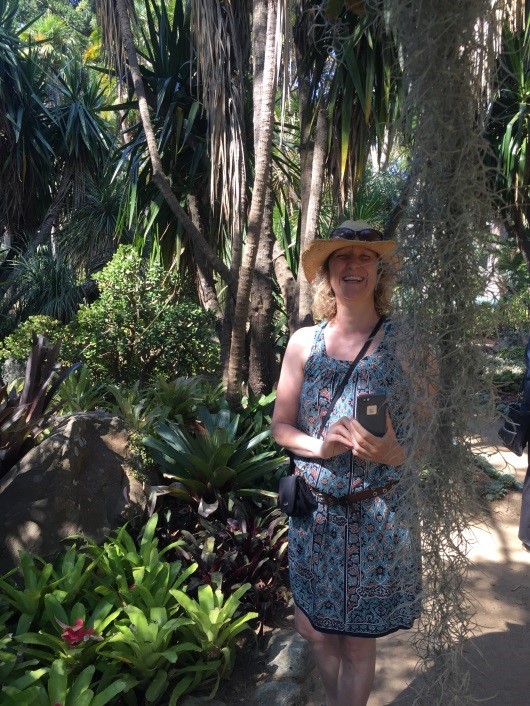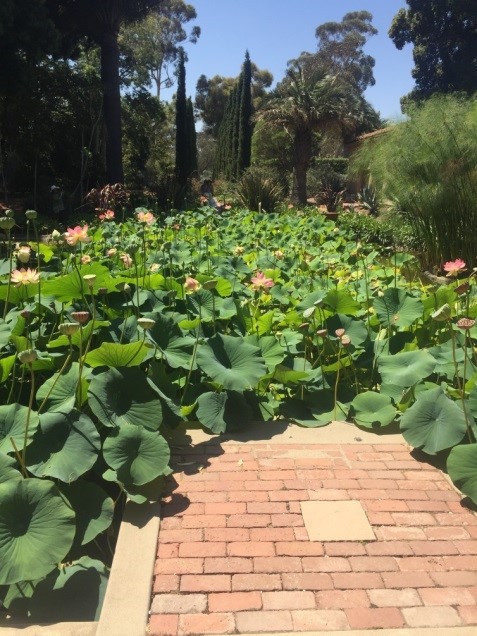Adventures in Lotusland
Editor's Note: With the recent cold and grey weather, we at Swansons thought it would be restorative to take a trip - albeit a virtual one - to the sunny climes of southern California. This is a peek at a visit to the renowned Lotusland gardens made by our Annuals and Indoor Plant Buyers, Liane and Mollie, this past August. We hope it leaves you feeling refreshed and even more ready for spring gardening!
Lotusland
In August, Mollie, our indoor plant buyer, and I were visiting growers in southern California and found ourselves with a free morning. Without knowing much more than that it had an acclaimed botanical garden we took the opportunity to visit Lotusland. What a fantastic place!
The Main House
Lotusland is a hidden gem in the foothills of Montecito, California; spilling across 37 acres on the historic estate of Madame Ganna Walska. I couldn’t help but feel we’d joined a secret (and highly dramatic) club right from the start. Because Lotusland is a public garden operating in a private, residential neighborhood, advance tour reservations are required to visit. Directions and parking information will only be provided once your reservation is confirmed. It brought to mind the mystery and excitement of being a nineteen-year-old, recently arrived in Paris, traveling from meeting point to meeting point awaiting the final directions to a dance party in an abandoned train tunnel. Who doesn’t love a good treasure hunt! We practiced the secret handshake diligently for a week before visiting. (I’m kidding about the secret handshake.) Is it weird that I find visiting a garden as scintillating an adventure as a rave was in my youth? Nope! Not when it’s Lotusland.
The feeling of adventure and discovery continued from the moment we arrived. Lotusland is a fabulous horticultural wonderland of whimsy, drama, and extravagance all brought together with the skill of a master show-woman. Every corner you turn is one of surprise and delight. A two hour, docent-led tour took us through a labyrinthine series of gardens, with subtropical and tropical plants from around the world. It was fun to see so many of the plants we grow in our homes used in mass in an outdoor environment, and fabulous to see them from the perspective of our indoor plant buyer, Mollie. Our docent gave historical and horticultural information sprinkled with just enough gossip to keep it spicy. While the plant nerd in me thrilled to see such an extensive and extravagant garden, the stories are what made it so enthralling.
A little history
1882-1913
Originally owned by British horticulturist Ralph Kinton Stevens, and named Tanglewood, the property was planted with many unusual specimens. Today you can still find many plants from this era including California live oaks, Monterey cypress, some really cool mature palms with trunks like an elephant’s legs, the Asian lotus in the Japanese gardens, and a beautiful promenade of olive trees in the orchard gardens.
1916-1938
Subsequent landowners E. Palmer and Marie Gavit renamed the estate Cuesta Linda (pretty hill). They commissioned many of the architectural features present today including the Spanish-Colonial Revival main residence, an Italianate garden, brick pathways, an eight-pointed Moorish garden, the pool house (later occupied by the Gavit’s teenage daughter), the swimming pool, and the pink perimeter wall, as well as several other outbuildings.
1941-1984
Opera diva Madame Ganna Walska acquired the property in 1941. Here’s where things started to get really interesting. She brought her considerable resources, passion, vision, and creativity to bear in crafting this botanical wonderland over the next forty plus years. In her autobiography, Madame Walska proclaimed herself an Enemy of the Ordinary. I’d say she was wildly successful in her quest and that her gardens are the living legacy of it.
“It is impossible to separate the creation from the creator. This is a very personal garden. It’s all Madame Ganna Walska,” said Gwen Stauffer, Lotusland’s executive director. “She was a collector by heart. She collected all kinds of things, and when she found out plants were collectible she was collecting them with a vengeance, from all over the world.” (Bock)
The Theater Garden
In 1948 Ganna Walska had a small outdoor theatre built to resemble the one at her French chateau. The Theater Garden holds seating for one hundred on three tiers of benches made of sandstone. Here she placed her collection of antique stone figures, called “grotesques” from her estate in Galluis, France, which she retrieved after World War II (they were rumored to have been buried during the war to protect them from theft). They are believed to be fashioned after engravings of “Gobbi” (literal translation: “Grotesque Dwarves”) made by French artist Jacques Callot in the 1600s, but little is known of their provenance.
Forty years later, there was little left except the stone steps. Isabelle Greene was commissioned to design a renovation that would “join hands” with Walska’s whimsical creativity throughout the Lotusland gardens. Walska’s collection of grotesques from France was brought out of storage. Although Isabelle’s original design called for pairs of them to symmetrically march throughout the theatre, when she saw them off-loaded from the truck in a group at the theatre edge, she laughed out loud, seeing a “flock of gremlins” about to swarm into her space. She decided to leave many of them where they stood so that others could enjoy the humor. Beyond the group, one cheeky grotesque showing his tongue peeks out behind an olive tree, while a flirtatious female displays her leg to an ogling monk nearby. (Isabelle Greene and Associates).
The Cycad Gardens
Thought to be the most complete cycad collection in any American public garden, this was the last garden created by Madame Walska. It has been called a “million dollar garden” because its development (and surely its funding) coincided with the auction of her remarkable jewelry collection at Sotheby’s in New York in 1971.
The “Walska Briolette Diamond” Brooch by Van Cleef & Arpels. Photo © Sotheby’s.
Three Encephalartos woodii, among the world’s rarest cycads and extinct in the wild, are placed on a rocky cliff above their own koi pond.
The term cycad is used to designate a group of unusual cone-bearing plants that were common during the time of the dinosaurs. Most species are endangered and some are extinct in the wild. Their extremely slow rate of growth and the hard-to-recognize differences among some species make buying mature specimens a costly proposition. Walska amassed 500 plants.
The Bromeliad Gardens
The two lush Bromeliad Gardens were my favorites. Bromeliads blanket the ground between large coast live oaks dripping with Spanish moss.
The Merritt Dunlap Cactus Garden
This extensive collection of columnar cacti was donated to Lotusland in 1999 by Merritt “Sigs” Dunlap, a longtime friend of Madame Walska. Dunlap began his prickly collection in 1929 and remarkably grew approximately 40 percent of the plants from seed. The garden was designed by Eric Nagelmann on three-quarters of an acre and contains about 300 different species of cacti, grouped by their country of origin. Pacific Horticulture has an excellent article on the garden here: http://www.pacifichorticulture.org/articles/cactus-garden-at-lotusland/
Cactus and Euphorbias gardens adorn the front of the main house looking like something out of a Doctor Seuss story.
The Fern Gardens
The Fern gardens feature some astoundingly large begonia specimens and enormous Australian Tree Ferns.
The Orchards
The Lotusland fruit orchards are divided between deciduous and citrus fruit trees. The deciduous orchard contains nearly one hundred fruit trees including peaches, plums, apples, pears, persimmons, and figs. Orange, lemon, lime, kumquat, grapefruit and guava trees are planted in the citrus orchard. Both orchards are heavily mulched, to the point that an active biological system provides nutrient cycling – and no fertilizing is needed. Much of the fruit is donated to the local food bank.
A circa 1920s arbor was replicated in 1988 with new Eureka lemon trees planted at each upright post, which since have been trained to cover the arbor.
The Lotus Garden
From 1946-1955, Ralph T. Stevens (son of the original owner) designed an entrance gate, the swimming pool and the beach area, the succulent wall, the Theatre Garden, the Blue Garden, the horticultural clock, and oversaw the conversion of the old swimming pool to a water garden where the namesake lotus grow. They only bloom for two months of the year and we were lucky enough to be there during the bloom. The blossoms practically glowed!
Madame Ganna Walska was a Polish-born opera singer who toured the world and married six times. Lotusland was the longest-lasting and arguably the greatest passion in her remarkable story. She was deeply involved in the design, care and development of her garden until the last few years of her life. Ganna Walska died in 1984 at the age of 96 inside her Lotusland.
*All photos taken by Liane, Mollie, or provided by Lotusland unless otherwise noted.








































